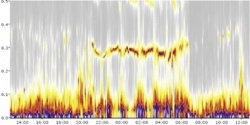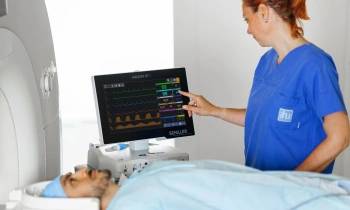Listen to your heart 24 hours a day
The ‘Fire of Life’ developed by Schiller is an intuitive visual presentation of frequency-domain heart rate variability (HRV) that makes the assessment of 24-hour results fast and simple.

In discussion with European Hospital, Dr René Hefti, senior consultant and medical director at Klinik SGM Langenthal spoke of his experiences with this unique system.
HRV analysis is important – Functional disturbances of the autonomic nervous system are always accompanied by reduced heart rate variability (HRV). With the heart being a central target organ of autonomic regulation, heart rate is a crucial regulation parameter for many processes in the body and offers a wealth of information on the functional status of the human organism.
Usually, heart rate is analysed statically, for example with spectral analysis, in order to filter relevant information. Conventional ECG devices compress the data and much information is lost. ‘However, the functional status of a highly complex system, such as our autonomic nervous system, cannot be described by a few parameters. The complete information can only be culled from the 120,000 RR intervals in 24 hours.
Schiller reports: ‘Fire of Life can present these data, which map the regulation processes of the autonomic nervous system, in a non-compressed way and in high resolution. This allows the integration of HRV analysis in many clinical specialities, such as internal medicine, cardiology, occupational medicine, psychiatry, psychosomatic medicine or sleep medicine.’
HRV in cardiology
‘In cardiology HRV is above all a risk marker: the lower the HRV, the higher the risk of cardiac events or cardiac death,’ says Dr René Hefti, senior consultant and medical director at Klinik SGM Langenthal, in Switzerland. He uses HRV analysis to record autonomic dysregulation in hypertensive patients, for example: ‘Some hypertensive patients are difficult to assess due to a number of stress factors, such as psychosocial stress, poor sleep quality, lack of physical exercise, etcetera. Thus hypertension ought not to be looked at as an isolated phenomenon. HRV allows us to gain a comprehensive picture of the regulation processes.’
The Fire of Life application mea-sures HRV over a 24-hour period thus providing information on the autonomic overall balance, sleep quality, the linkage between respiration and heart rate and similar indicators to support management of the hypertensive patient. ‘The application’s spectral images show the quality of the regulation processes while the frequency values offer quantitative data,’ the cardiologist explains. ‘I don’t need HRV to diagnose hypertension, but I do need it to understand whether and to which extent hypertension is accompanied by autonomic dysfunction.’
Individualised therapy
The results of the HRV analysis provide crucial information for an individualised therapy of the hypertensive patient. ‘If we see pronounced sympathetic dominance, which continues through the night and is accompanied by reduced vagal activity, we not only need drugs that decrease sympathetic tone but also immediate measures to increase vagal activity, such as regular physical exercise or deep relaxation techniques, for example based on HRV bio-feedback. At the same time, risk factors and psychosocial stress need to be reduced,’ he explains.
Long-term HRV measurements allow the physician to monitor the quantitative efficacy of measures. If the sympathetic tone decreases and vagal tone increases, which indicates a better balance of the autonomic nerve system, measures are effective.
In addition, the easy-to-understand spectral images play an important long-term role in guiding and motivating the patient. 24-hour HRV monitoring can be used in the same way to manage other cardiovascular diseases such as coronary heart disease.
Uncompressed and visual presentation of HRV with Schiller’s Fire of Life
• Analysis of the autonomic balance: the relationship between sympathetic and parasympathetic
activity over a 24-hour period
• Analysis of the structure and quality of sleep and respiratory events
• Visualisation of baroreceptor data and blood pressure regulation analysis
• Stress and recovery management (burnout prophylaxis)
• Quantification of autonomic dysfunctions, such as diabetes mellitus
24h HRV assessment with spectral analysis: spectral image of a 27-year-old female patient with stress-related arterial hypertension. Good and age-conforming regulation capability (SDNN 220 ms) with slight parasympathetic dominance (RMSSD 52, Log LF/HF 0.38), retained sleep structure with rhythmic deep sleep phases, pronounced REM (rapid eye movement). No signs of sustained autonomic dysfunction.
24h HRV assessment with spectral analysis and HR trending: spectral image of a 58-year-old male patient with arterial hypertension and CHD. The total regulation capability (Total Power 1192, SDNN 84 ms) is reduced and not age-conforming. Significantly reduced parasympathetic activity (RMSSD 9ms) is accompanied by a relative sympathetic dominance (Log LF/HF 0.87). Sleep structure is to a large extent retained, but heart rate (HR) drops below 60 bpm during the night.
Profile:
Dr René Hefti is senior consultant and medical director at Klinik SGM Langenthal, Switzerland, and teaches psychosocial medicine at the University of Berne. He attended medical school at the University of Zurich and following his graduation in 1987 he gained experience in internal medicine and cardiology at different hospitals in Switzerland and Austria. In 1998 he participated in a research project on cardiac insufficiency and beta blockers at Kuwait University Hospital in Sanaa, Jemen. Dr Hefti focuses on stress physiology, autonomic regulation, heart rate variability (HRV) and psychosocial components of cardiovascular disease.
02.09.2014
- cardiology (771)
- cardiovascular diseases (730)
- imaging (1629)
- monitoring (374)
- testing devices (158)











